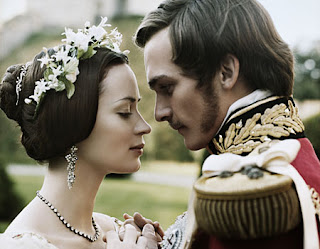
It’s not easy being queen
by Thomas Delapa
This is not your father’s Queen Victoria. Nor even your grandfather’s. The teen monarch of Young Victoria is hardly Victorian--sniff--at least not in the stuffy, we-are-not-amused sense of the word.
In this handsomely mounted but breezy chronicle of the early years of Victoria’s epic reign on the British throne, actress Emily Blunt abdicates pomp and circumstance in favor of a humanized portrait that doesn’t bow to the faded conventions of the historical biopic.
In the crowded gallery of recent royals, Young Victoria sits somewhere between Cate Blanchett’s lauded Elizabeth and Kirsten Dunst’s laughable Marie Antoinette, with all three head and shoulders below Hellen Mirren’s Oscar-winning The Queen. At their own risk, director Jean-Marc Vallee and screenwriter Julian Fellowes curiously gloss over the major events in Victoria’s reign--um, like her coronation--while Enquiring into her private life, principally her courtship and marriage to Prince Albert (Rupert Friend) of Germany. What Vallee gains in intimacy and Victorian secrets, he loses in depth and grandeur.
Blessed with courtly diction and a winsome demeanor, Blunt is the Vallee’s crowning attraction, especially when poised in the plush costumes and an array of palatial interiors from Lincoln Cathedral to London’s Lancaster House. In a supporting role, Paul Bettany stands out as Lord Melbourne, the shrewd Whig leader who becomes Victoria’s confidante once she ascends to the throne in 1837.
In a whirlwind 100 minutes, Vallee and Fellowes barely scratch the surface of a momentous reign that lasted longer than any other in British history, and one that saw England evolve (and downsize) from industrial empire into modern, 20th-century nation. What we do learn, rather fitfully, is that teen Victoria was at the center of a power play between volatile King William (Jim Broadbent) and Victoria’s manipulative mother (Miranda Richardson) and sinister uncle (Mark Strong), with distant uncle King Leopold (Thomas Kretschmann) of Belgium more than interested spectator. At issue is whether Victoria will duly take the crown at 18, or whether she will only nominally serve while her mother and uncle act as “temporary” regents. “Do you ever feel like you’re a chess piece?” she transparently asks the smitten Albert during their own game.
While satisfying on visual level, as drama Young Victoria is a stalemate. Fellowes often proclaims the obvious, yet seems to turn up his nose at nuance. He does only a passable job untangling all the political machinations afoot, such as the tempest-in-a-teapot that brews when the Queen refuses to dismiss her Whig ladies-in-waiting with the election of Tory leader Robert Peel as prime minister. While seemingly trivial today, the act almost brought down the House (of Commons).
In their quest to popularize this young, romantic Victoria, the filmmakers anoint the production with a king’s ransom of majestic eye candy. But calorie counters need not fret: Perhaps owing to Sarah Ferguson’s role as producer, this is assuredly Victoria Lite.
---------------















